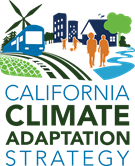 The world’s leading climate scientists have made it clear - our window to avoid the worst impacts of climate change is narrowing faster than expected, and success requires unprecedented collective effort and transformational change.
The world’s leading climate scientists have made it clear - our window to avoid the worst impacts of climate change is narrowing faster than expected, and success requires unprecedented collective effort and transformational change.
The 2021 California Climate Adaptation Strategy reflects an evolved approach. It outlines the state's key climate resilience priorities, includes specific and measurable actions, and serves as a framework for collective efforts across sectors and regions in California.
The Climate Adaptation Strategy elevates six key priorities that must drive all resilience actions in California:
- Strengthen Protections for Climate Vulnerable Communities
- Bolster Public Health and Safety to Protect Against Increasing Climate Risks
- Build a Climate Resilient Economy
- Accelerate Nature-Based Climate Solutions and Strengthen Climate Resilience of Natural Systems
- Make Decisions Based on the Best Available Climate Science
- Partner and Collaborate to Leverage Resources
We are currently updating the 2024 California Climate Adaptation Strategy. Please visit our main Adaptation Strategy webpage for the latest: https://climateresilience.ca.gov/
The 2021 Climate Adaptation Strategy is being presented as an interactive website that will serve as a central hub for information on the state’s climate resilience actions. Click here to explore the California Climate Adaptation Strategy.
FAQ - Updated California Climate Adaptation Strategy
The updated strategy builds on successful elements of previous strategies, and reflects recent efforts to double down on protecting communities, our economy, and nature from the impacts of climate change. This update:
- Organizes the state’s climate adaptation efforts around six outcome-based resilience priorities, and increases our ability to measure progress.
These priorities reflect and reinforce regional climate resilience priorities; were developed through robust public engagement and in consultation with California Native American tribes; and specify timeframes and metrics to drive progress and enable accountability.
- Breaks down siloes and unifies collective climate adaptation efforts across all sectors and regions.
An outcome-based approach sets strategic direction, supports coordinated, integrated efforts, recognizes how climate adaptation is implemented on the ground, and reflects our commitment to integrating climate resilience into the work of all state agencies.
- Makes it easier for Californians to understand and contribute to California’s climate resilience agenda.
Presented as an interactive website, the Strategy provides a central hub for information on the state’s climate resilience actions. The website will stay updated to track progress and adjustments, and integrate emerging best available science.
California is required by statute (Public Resources Code §71150 - 71160) to issue an updated climate adaptation strategy every three years, and to report on progress annually. The 2022 Implementation Progress Report summarizes the state's overall progress in 2022 to implement the 2021 Strategy and highlights key accomplishments that support the Strategy's six priorities:
The 2023 Implementation Report will be released in early 2024.
California’s Extreme Heat Action Plan was released April 28, 2022. The plan provides a strategic and comprehensive set of state actions to adapt and build resilience to extreme heat. It outlines California’s all-of-government approach to mitigating the health, economic, cultural, ecological, and social impacts of increasing average temperatures and heatwaves.
Read the Extreme Heat Action Plan (18 MB)
The content and organization of this plan were guided by extensive public input, including listening sessions, regional workshops, as well as consultations with California’s Native American Tribes.
Background
The development of the action plan was initiated through the state’s 2021 update to California’s Climate Adaptation Strategy. The public input process helped to identify and fill key gaps in adaptation actions, for example, recognizing a need for an updated, integrated approach to addressing climate-driven extreme heat and driving an update and expansion of the state’s 2013 report on extreme heat (“Preparing California for Extreme Heat Guidance and Recommendations”).
The Extreme Heat Action Plan outlines areas of near-term focus and is organized into four action tracks:
- Building Public Awareness and Notification, to increase understanding of the threats posed by increasing temperatures and preparation for extreme heat events.
- Strengthening Community Services and Response, to increase community capacity, reduce the economic risks of extreme heat, and increase efforts to protect vulnerable populations.
- Increasing Resilience of Our Built Environment, to drive actions in the transportation, energy, and building sectors that reduce heat risks.
- Utilizing Nature-Based Solutions, to cool vulnerable communities and build resilience of natural systems to the impacts of extreme heat.
In October 2022, we hosted California’s first Extreme Heat Symposium to build on the work of the Extreme Heat Action Plan and inform heat adaptation decision-making and actions across sectors and regions.



